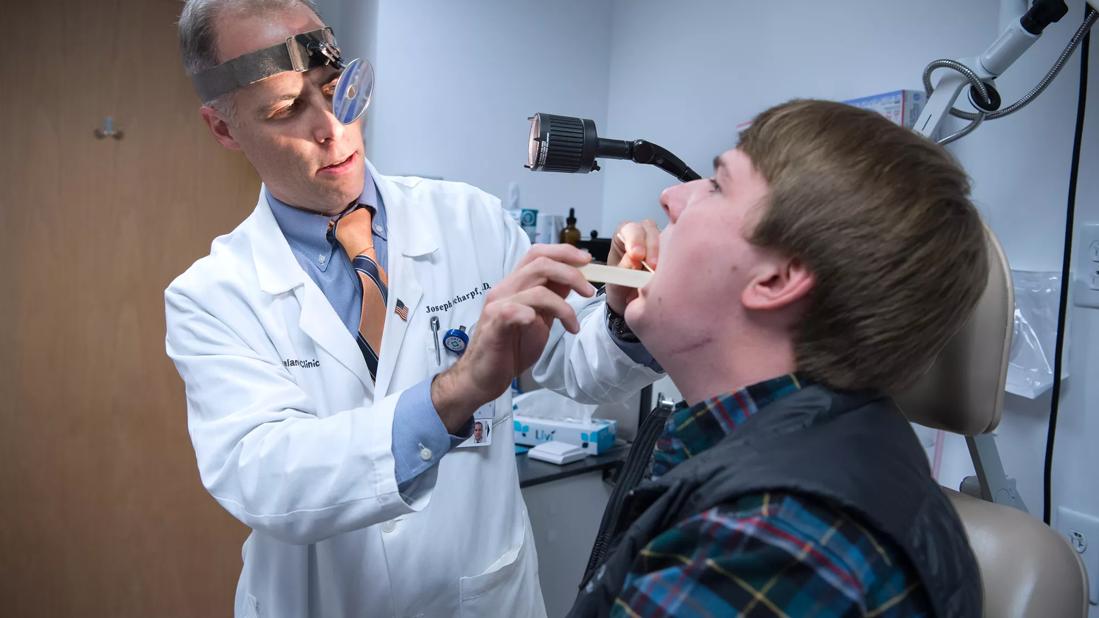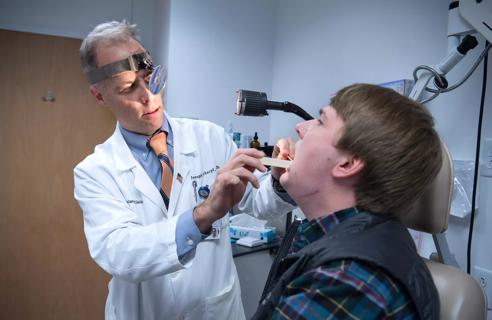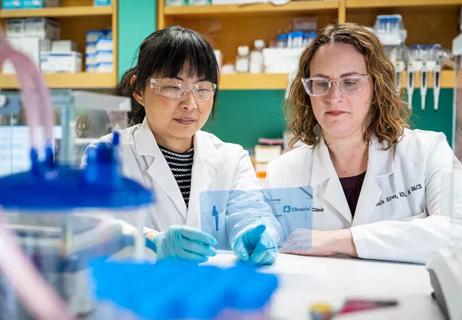Strong communication with the patient and a thorough approach are essential

While thyroidectomy is typically safe and effective, like any surgical procedure, it is not without its risks. Understanding how to avoid potential complications, such as injury to the recurrent laryngeal (RLN) or superior laryngeal nerves (SLN), is key to positive patient outcomes.
Advertisement
Cleveland Clinic is a non-profit academic medical center. Advertising on our site helps support our mission. We do not endorse non-Cleveland Clinic products or services. Policy
In a recently published paper, “Avoiding Complications of Thyroidectomy: Recurrent Laryngeal Nerve and Superior Laryngeal Nerve Preservation,” Joseph Scharpf, MD, Department of Otolaryngology-Head and Neck Surgery, Cleveland Clinic, alongside his colleague Kevin Y. Liang, MD, discuss how to best approach this procedure and minimize the risk of injury to the RLN and SLN (Otolaryngol Clin North Am. 2024;57(1):75-82).
Prior research estimates that the incidence of rate of temporary and permanent RLN palsy after thyroidectomy is 9.8% and 2.3%, respectively. Although rare, recurrent laryngeal nerve injury during thyroidectomy can have significant morbidity, according to Drs. Scharpf and Liang.
A less commonly discussed complication is injury to the SLN. “The external branch provides motor innervation to the cricothyroid muscle, which tenses the vocal fold and elevates pitch. Injury rates in the literature vary widely and can be up to 58%. Less is known about SLN injuries perhaps because the clinical manifestations are more subtle,” says Dr. Scharpf.
Preserving the recurrent laryngeal or superior laryngeal nerves begins during the initial patient evaluation. The first step, says Dr. Scharpf, is gathering a thorough history, especially for voice or swallow complaints. He also recommends that any prior skull base, neck or chest surgery should be noted, including the laterality.
“From there, I will conduct a comprehensive physical examination that includes subjective and objective evaluation of vocal fold function,” Dr. Scharpf explains. “There are patients who may have underlying issues despite a relatively normal sounding voice, and it is important to gather as much information as possible prior to surgery.”
Advertisement
The physical examination is then followed by preoperative imaging with ultrasound and possibly cross-sectional imaging. This can alert the surgeon to the anatomic location of the nerves based on the thyroid shape and size, according to Dr. Scharpf. In the case of abnormal masses of the thyroid or lymph nodes, his team will conduct ultrasound-guided fine needle biopsies to confirm the diagnosis of a potential cancer. Molecular testing can provide further information if needed.
“Preoperative planning is crucial,” Dr. Scharpf emphasizes. “It is also very important to have long and detailed discussions with the patients regarding the indications for surgery as well as the risks, benefits, alternatives, and personnel of the surgery. We engage patients in the ultimate decision of surgery versus other alternative options.”
A key aspect of a successful thyroidectomy that should not be overlooked is meticulous hemostasis throughout the procedure. “This provides the surgeon with the optimal view to identify critical landmarks that lead to identifying the nerves,” explains Dr. Scharpf. “This process is greatly aided when the tissue is not blood-stained. In many instances, simple direct pressure with a gauze will stop most low-volume oozing.”
When it is necessary to control the bleeding, they advocate for precise bipolar cautery, surgical clips or suture tying rather than monopolar cautery. Advanced energy devices can also be effective.
Dr. Scharpf recommends keeping dissection directly on the thyroid capsule to minimize injury risk to the nerves as well as parathyroid glands and other surrounding tissue. “In addition to precise anatomic dissection and hemostasis without heat injury to the nerve, careful awareness of maintaining minimal traction on a very delicate RLN is of utmost importance.”
Advertisement
Intraoperative neural monitoring (IONM) during thyroid surgery, which has been more widely adopted in recent years, can be a valuable tool, particularly when it comes to providing prognostication regarding RLN function.
“An identified, recurrent nerve to the voice box that goes through the thyroid can be intact yet non-functional if there is a weakness from the neuropraxia,” says Dr. Scharpf. “The neural monitoring can give you valuable information regarding if the nerve is weakened or if it's changing even during the course of an operation. For instance, you can get information that tells you to change some of your retraction on the gland to help prevent the nerve from becoming further weakened.”
When identifying the recurrent laryngeal nerve, Dr. Scharpf notes that it is often found either in the tracheoesophageal groove from an inferolateral approach or more superiorly before it enters the larynx. Another important takeaway from the paper is the highly variable anatomy of the external branch of the SLN. “Dissecting out the superior pole must be performed methodically to avoid injuring this nerve,” advise Drs. Scharpf and Liang.
At Cleveland Clinic, taking the steps discussed above coupled with a multidisciplinary approach ensures patients will have the best possible outcomes. “We take all the necessary precautions to lessen the risk of complications,” says Dr. Scharpf. “We also work as a team across disciplines when caring for these patients. This is particularly important for advanced thyroid cancers where there may be a need for medical oncology, targeted drug therapies, and even radiation oncology, depending on the nature of the cancer.
Advertisement
“One of the things that's practiced quite well at the Cleveland Clinic is this multidisciplinary approach we take for all our thyroid patients,” he concludes.
Advertisement
Advertisement

Dynamic risk assessment may aid clinicians in helping support informed treatment decisions

A new study indicates that the combined approaches can be performed without mortality and with acceptable morbidity

Case study illustrates the potential of a dual-subspecialist approach

Evidence-based recommendations for balancing cancer control with quality of life

Study shows no negative impact for individuals with better contralateral ear performance

HNS device offers new solution for those struggling with CPAP

Patient with cerebral palsy undergoes life-saving tumor resection

Specialists are increasingly relying on otolaryngologists for evaluation and treatment of the complex condition